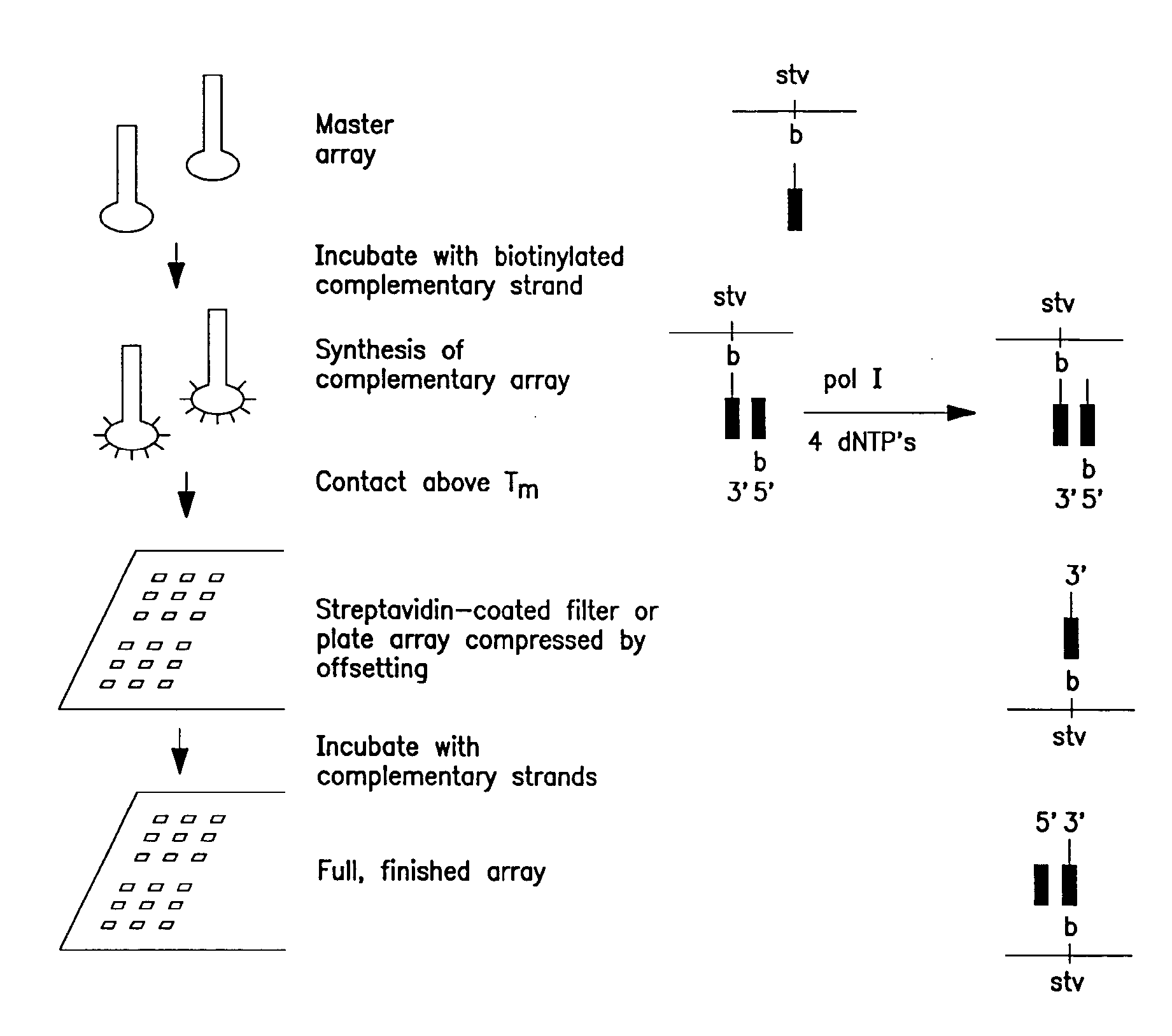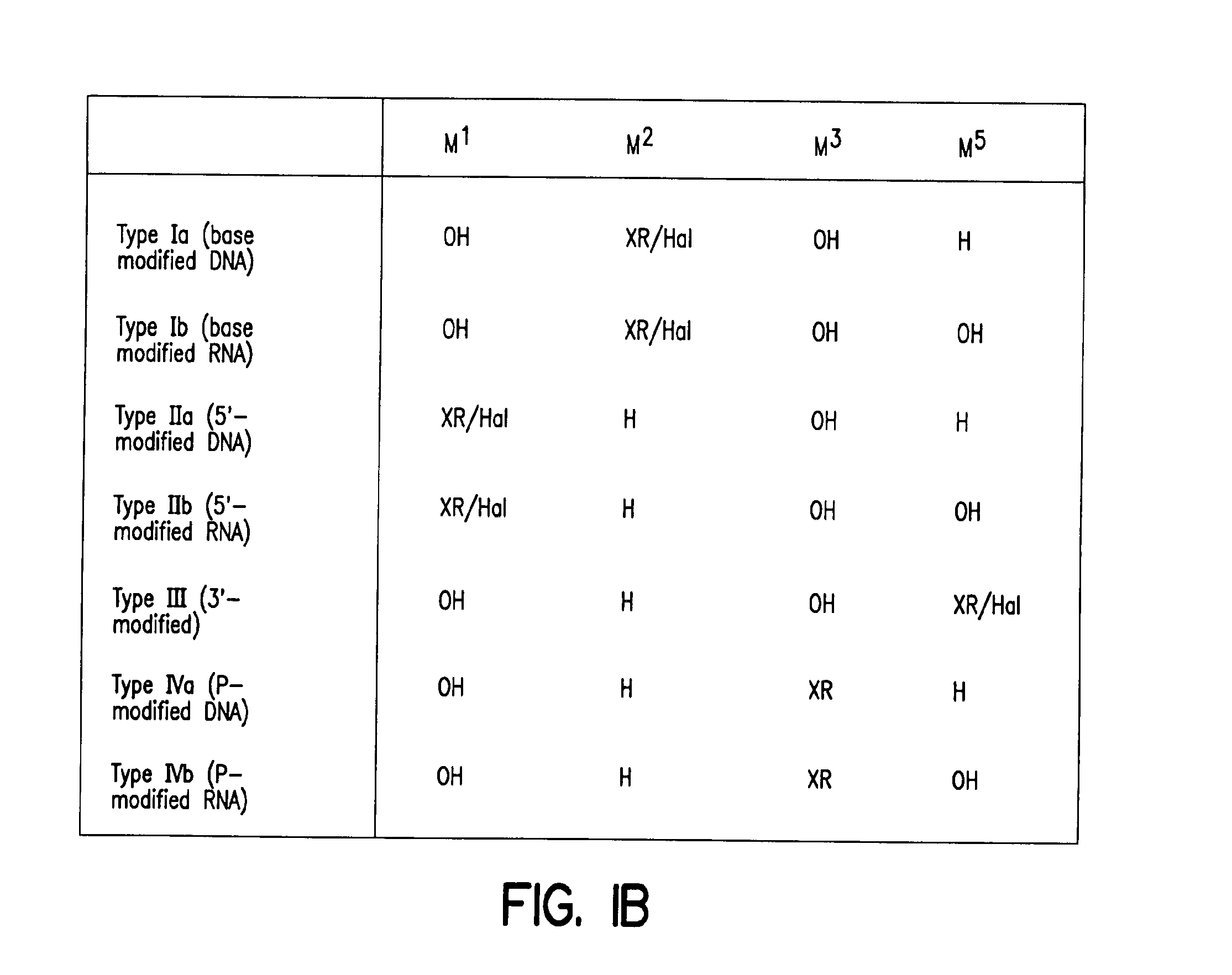Solid phase sequencing of biopolymers
a biopolymer and solid-phase sequencing technology, applied in the field of solid-phase sequencing of biopolymers, can solve the problems of cumbersome and impractical procedures, limited procedures to sequencing dna, and it is still not possible using either process to obtain sequence information directly from any other form of nucleic acid, so as to facilitate automated determination of molecular weights
- Summary
- Abstract
- Description
- Claims
- Application Information
AI Technical Summary
Benefits of technology
Problems solved by technology
Method used
Image
Examples
example 1
Preparation of Target Nucleic Acid
[0119]Target nucleic acid is prepared by restriction endonuclease cleavage of cosmid. DNA. The properties of type II and other restriction nucleases that cleave outside of their recognition sequences were exploited. A restriction digestion of a 10 to 50 kb DNA sample with such an enzyme produced a mixture of DNA fragments most of which have unique ends. Recognition and cleavage sites of useful enzymes are shown in Table 1.
TABLE 1Restriction Enzymes and Recognition Sites for PSBH ↓Mwo IGCNNNNN-NNGCCGNN-NNNNNCG ↑ ↓Esi YICCNNNNN-NNGGGGNN-NNNNNCC ↑ ↓Apa BIGCANNNNN-TGCCGT-NNNNNACG ↑ ↓Mnl ICCTCN7GGAGN6 ↑ ↓TspR INNCAGTGNNNNGTCACNN↑ ↓Cje ICCANNNNNN-GTNNNNGGTNNNNNN-CANNNN ↑ ↓Cje PICCANNNNN-NNTCNNGGTNNNNN-NNAGNN ↑
[0120]One restriction enzyme, ApaB15, with a 6 base pair recognition site may also be used. DNA sequencing is best served by enzymes that produce average fragmen...
example 2
Basic Aspects of Positional Sequencing by Hybridization
[0127]An examination of the potential advantages of stacking hybridization has been carried out by both calculations and pilot experiments. Some calculated Tm's for perfect and mismatched duplexes are shown in FIG. 7. These are based on average base compositions. The calculations revealed that the binding of a second oligomer next to a preformed duplex provides an extra stability equal to about two-base pairs and that mispairing seems to have a larger consequence on stacking hybridization than it does on ordinary hybridization. Other types of mispairing are less destabilizing, but these can be eliminated by requiring a ligation step. In standard SBH, a terminal mismatch is the least destabilizing event, and leads to the greatest source of ambiguity or background. For an octanucleotide complex, an average terminal mismatch leads to a 6° C. lowering in Tm. For stacking hybridization, a terminal mismatch on the side away from the p...
example 3
Preparation of Model Arrays
[0128]In a single synthesis, all 1024 possible single-stranded probes with a constant 18 base stalk followed by a variable 5 base extension can be created. The 18 base extension is designed to contain two restriction enzyme cutting sites. Hga I generates a 5 base, 5′ overhang consisting of the variable bases N5. Not I generates a 4 base, 5′ overhang at the constant end of the oligonucleotide. The synthetic 23-mer mixture hybridized with a complementary 18-mer forms a duplex which can be enzymatically extended to form all 1024, 23-mer duplexes. These are cloned by, for example, blunt end ligation, into a plasmid which lacks Not I sites. Colonies containing the cloned 23-base insert are selected and each clone contains one unique sequence. DNA minipreps can be cut at the constant end of the stalk, filled in with biotinylated pyrimidines and cut at the variable end of the stalk to generate the 5 base 5′ overhang. The resulting nucleic acid is fractionated by ...
PUM
| Property | Measurement | Unit |
|---|---|---|
| molecular weights | aaaaa | aaaaa |
| temperature | aaaaa | aaaaa |
| temperature | aaaaa | aaaaa |
Abstract
Description
Claims
Application Information
 Login to View More
Login to View More - R&D
- Intellectual Property
- Life Sciences
- Materials
- Tech Scout
- Unparalleled Data Quality
- Higher Quality Content
- 60% Fewer Hallucinations
Browse by: Latest US Patents, China's latest patents, Technical Efficacy Thesaurus, Application Domain, Technology Topic, Popular Technical Reports.
© 2025 PatSnap. All rights reserved.Legal|Privacy policy|Modern Slavery Act Transparency Statement|Sitemap|About US| Contact US: help@patsnap.com



